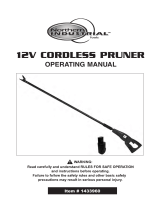Toro Cordless Pole Saw 60V MAX* Flex-Force Power System 51847T – Tool Only User manual
- Category
- Power tools
- Type
- User manual
Toro Cordless Pole Saw 60V MAX* Flex-Force Power System 51847T – Tool Only is a powerful and versatile tool designed for trimming small branches and limbs up to 6 inches in diameter. It is equipped with a 60V lithium-ion battery pack that provides ample power for extended use. The pole saw features a lightweight and balanced design for easy maneuverability, even when working at extended heights. With its quick-release harness, you can operate the saw comfortably and safely. The automatic oiler ensures a smooth and efficient cutting operation.
Toro Cordless Pole Saw 60V MAX* Flex-Force Power System 51847T – Tool Only is a powerful and versatile tool designed for trimming small branches and limbs up to 6 inches in diameter. It is equipped with a 60V lithium-ion battery pack that provides ample power for extended use. The pole saw features a lightweight and balanced design for easy maneuverability, even when working at extended heights. With its quick-release harness, you can operate the saw comfortably and safely. The automatic oiler ensures a smooth and efficient cutting operation.



















-
 1
1
-
 2
2
-
 3
3
-
 4
4
-
 5
5
-
 6
6
-
 7
7
-
 8
8
-
 9
9
-
 10
10
-
 11
11
-
 12
12
-
 13
13
-
 14
14
-
 15
15
-
 16
16
-
 17
17
-
 18
18
-
 19
19
-
 20
20
-
 21
21
-
 22
22
-
 23
23
-
 24
24
Toro Cordless Pole Saw 60V MAX* Flex-Force Power System 51847T – Tool Only User manual
- Category
- Power tools
- Type
- User manual
Toro Cordless Pole Saw 60V MAX* Flex-Force Power System 51847T – Tool Only is a powerful and versatile tool designed for trimming small branches and limbs up to 6 inches in diameter. It is equipped with a 60V lithium-ion battery pack that provides ample power for extended use. The pole saw features a lightweight and balanced design for easy maneuverability, even when working at extended heights. With its quick-release harness, you can operate the saw comfortably and safely. The automatic oiler ensures a smooth and efficient cutting operation.
Ask a question and I''ll find the answer in the document
Finding information in a document is now easier with AI
Related papers
Other documents
-
DeWalt DCCS623 20V Max* Pruner User manual
-
 Northern Industrial Tools ET2701 Owner's manual
Northern Industrial Tools ET2701 Owner's manual
-
Ryobi P20310 User manual
-
Ryobi R18PP22 User manual
-
Ryobi RPP3600 User manual
-
Gardena 14770 User manual
-
DeWalt DCMPS520N User manual
-
Greenworks 20612 Owner's manual
-
DeWalt DCMPS520P2 User manual
-
Makita UC100D User manual

























